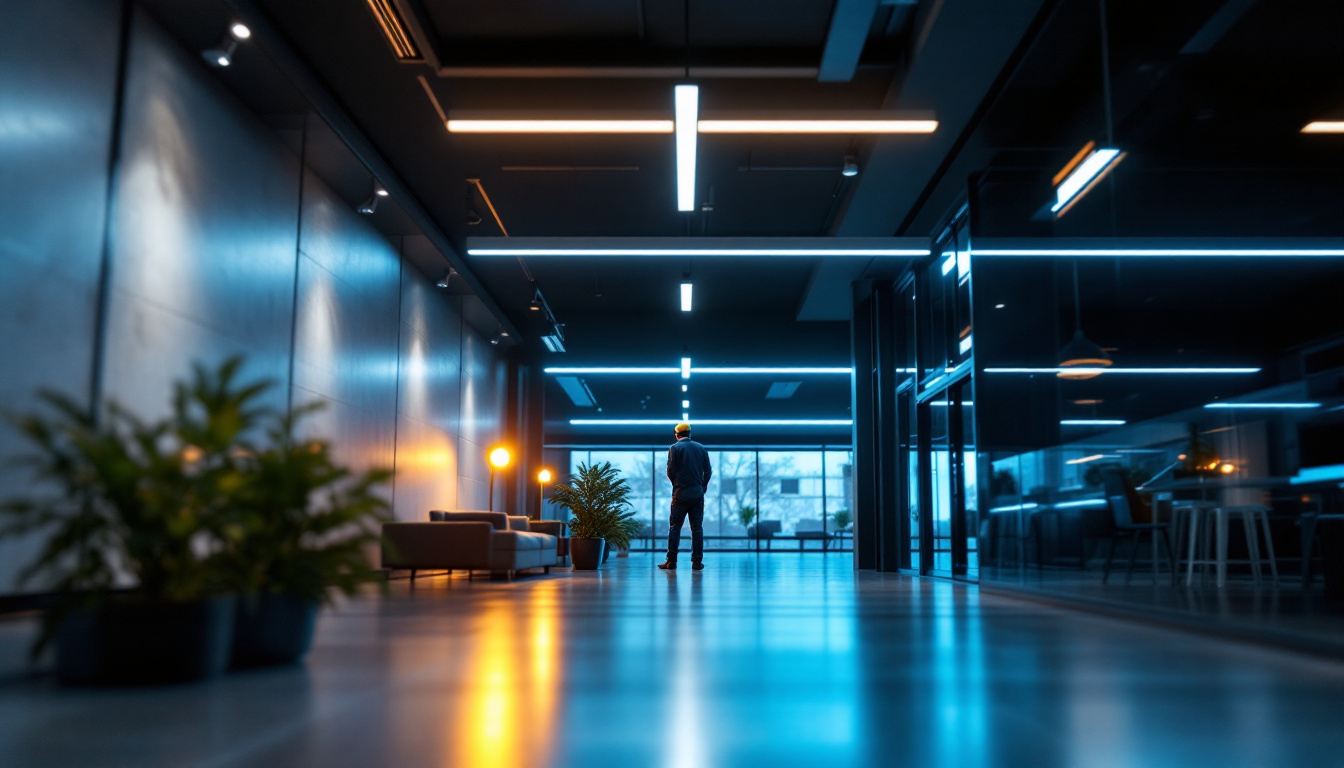
In the ever-evolving world of commercial lighting, LED spotlights have emerged as a popular choice among lighting contractors. Their energy efficiency, longevity, and versatility make them an ideal solution for a variety of applications. This article aims to provide comprehensive insights into commercial LED spotlights, covering essential aspects that every lighting contractor should understand.
LED, or Light Emitting Diode, technology has revolutionized the lighting industry. Unlike traditional incandescent or fluorescent bulbs, LEDs produce light through a semiconductor, which results in lower energy consumption and a longer lifespan. This innovative approach not only minimizes environmental impact but also aligns with the growing demand for sustainable and energy-efficient solutions in various sectors.
One of the primary advantages of LED spotlights is their energy efficiency. They consume significantly less power compared to traditional lighting options, which can lead to substantial cost savings for commercial clients. Additionally, LED spotlights have a lifespan that can exceed 25,000 hours, reducing the frequency of replacements and maintenance. This durability is particularly beneficial for businesses that rely on consistent lighting for operations, as it minimizes disruptions and associated costs.
Furthermore, LED spotlights emit less heat, which not only enhances safety but also contributes to lower cooling costs in commercial spaces. This characteristic makes them particularly suitable for environments where heat generation is a concern, such as galleries, retail stores, and offices. In fact, the reduced thermal output of LEDs can help maintain a comfortable atmosphere for both employees and customers, promoting productivity and satisfaction in the workplace.
Another critical aspect of LED spotlights is their ability to produce various color temperatures. Measured in Kelvin (K), color temperatures can range from warm white (around 2700K) to cool white (up to 6500K). Understanding the desired ambiance of a space can help contractors recommend the right color temperature for their clients. For instance, warmer tones are often preferred in residential settings for a cozy feel, while cooler tones can enhance focus and alertness in office environments.
Moreover, the Color Rendering Index (CRI) is a vital factor in determining the quality of light emitted by LED spotlights. A higher CRI means that colors appear more vibrant and true to life. For commercial applications, especially in retail and hospitality, a CRI of 90 or above is often recommended to enhance the visual appeal of products and spaces. This is crucial in settings like art galleries or fashion boutiques, where accurate color representation can significantly influence purchasing decisions. The ability of LED spotlights to maintain consistent color quality over time further solidifies their position as a preferred lighting solution in various industries.
Commercial LED spotlights are versatile and can be used in various settings. Understanding the specific applications can help contractors tailor their offerings to meet client needs effectively.
In retail environments, effective lighting is essential for showcasing products and creating an inviting atmosphere. LED spotlights can be strategically placed to highlight merchandise, draw attention to displays, and enhance the overall shopping experience. Their adjustable beam angles allow for focused lighting, which is particularly beneficial in showcasing specific items.
Additionally, the ability to change color temperatures can help retailers create seasonal displays or themed environments, further enhancing customer engagement. For instance, warmer tones can evoke a sense of comfort during holiday seasons, while cooler tones can create a sleek, modern feel for contemporary fashion lines. Moreover, the integration of LED spotlights with smart technology can enable retailers to dynamically alter lighting schemes based on customer traffic patterns, ensuring that the most popular items are always well-lit and inviting.
In the hospitality sector, lighting plays a crucial role in setting the mood. Restaurants, hotels, and event spaces often use LED spotlights to create warm and inviting atmospheres. By employing dimmable LED spotlights, contractors can offer clients the flexibility to adjust lighting levels according to different times of day or events.
Moreover, LED spotlights can be used in outdoor settings, such as patios and gardens, to extend the usable space while maintaining a cozy ambiance. The energy efficiency of LEDs also aligns with the sustainability goals many hospitality venues are striving to achieve. Beyond aesthetics, the use of LED lighting can significantly reduce energy costs, allowing businesses to allocate resources to other areas, such as customer service and menu development. Additionally, the durability of LED fixtures makes them ideal for high-traffic areas, where traditional bulbs might fail more frequently, ensuring a consistent guest experience.
In office settings, proper lighting is essential for productivity and employee well-being. LED spotlights can be integrated into office designs to provide focused task lighting, reducing eye strain and enhancing concentration. Additionally, the long lifespan of LED spotlights means less disruption due to maintenance, which is a significant advantage in busy office environments.
Smart lighting systems that incorporate LED technology can further enhance office spaces by allowing for automated adjustments based on occupancy and natural light levels. This not only improves energy efficiency but also creates a more comfortable working environment. For example, during collaborative meetings, adjustable LED spotlights can be dimmed to create a more relaxed atmosphere, while task areas can be illuminated brightly to enhance focus. Furthermore, the ability to customize lighting settings can cater to individual employee preferences, fostering a more inclusive workplace where everyone feels comfortable and productive. The integration of circadian lighting principles, which mimic natural daylight patterns, can also support employee health and well-being, leading to improved morale and reduced absenteeism.
When selecting LED spotlights for commercial applications, several factors must be considered to ensure the best outcomes for clients.
Understanding the relationship between wattage and lumen output is crucial for contractors. While wattage indicates energy consumption, lumen output measures the brightness of the light. LED technology allows for lower wattage while providing high lumen output, making them an efficient choice for various applications.
Contractors should assess the lighting needs of the space and recommend LED spotlights that provide adequate brightness without excessive energy consumption. This approach not only meets client expectations but also aligns with energy-saving initiatives.
The beam angle of an LED spotlight determines how focused or dispersed the light is. A narrow beam angle is suitable for highlighting specific areas or objects, while a wider beam angle is ideal for general illumination. Contractors should consider the intended use of the spotlight and the layout of the space when recommending beam angles.
For instance, in a gallery setting, a narrow beam angle may be preferred to highlight individual artworks, while a wider beam angle may be more appropriate for a retail space aiming for overall illumination.
Proper installation and maintenance are vital for maximizing the performance and lifespan of LED spotlights. Here are some essential tips for lighting contractors.
When installing LED spotlights, it’s crucial to follow manufacturer guidelines to ensure optimal performance. This includes considerations for wiring, mounting heights, and spacing between fixtures. Proper alignment and positioning can significantly impact the effectiveness of the lighting design.
Additionally, using dimmers and smart controls can enhance the functionality of LED spotlights, allowing clients to adjust lighting levels according to their needs. Contractors should educate clients on how to use these features effectively to maximize their investment.
While LED spotlights have a long lifespan, regular maintenance checks can help identify any potential issues before they become significant problems. This includes inspecting fixtures for dust accumulation, ensuring proper functioning of dimmers, and checking for any signs of damage.
Contractors should also stay informed about advancements in LED technology, as new products and features are continually being developed. This knowledge can help contractors provide the best recommendations and solutions for their clients.
As energy efficiency becomes increasingly important in commercial lighting, LED spotlights stand out as a sustainable choice. Their low energy consumption not only reduces utility costs but also contributes to a smaller carbon footprint.
Many regions offer incentives and rebates for businesses that invest in energy-efficient lighting solutions. Contractors should be aware of these programs and inform clients about potential savings. This can be a significant selling point when discussing the benefits of LED spotlights.
Furthermore, promoting the sustainability aspect of LED technology can resonate with environmentally conscious clients. Highlighting the reduced waste associated with longer-lasting products can enhance the appeal of LED spotlights in commercial applications.
The LED lighting industry is continually evolving, with new technologies and trends emerging regularly. One notable trend is the integration of smart technology, allowing for more control and customization of lighting systems. This includes features like remote access, automated adjustments, and energy monitoring.
Contractors should stay updated on these trends to provide clients with cutting-edge solutions that enhance their lighting systems. Embracing new technologies can also open up new business opportunities and set contractors apart from competitors.
Commercial LED spotlights offer numerous advantages for lighting contractors and their clients. Understanding the technology, applications, and best practices for installation and maintenance is essential for maximizing the benefits of LED lighting. By staying informed about energy efficiency, sustainability, and emerging trends, contractors can provide valuable insights and solutions that meet the evolving needs of commercial spaces.
As the demand for energy-efficient and versatile lighting solutions continues to grow, LED spotlights will undoubtedly remain a key component in the commercial lighting landscape. By embracing this technology, lighting contractors can enhance their offerings and contribute to a more sustainable future.
Ready to elevate your lighting projects with the efficiency and sustainability of commercial LED spotlights? At LumenWholesale, we provide lighting contractors like you with the highest quality, spec-grade lighting products at prices that can’t be beaten. Say goodbye to local distributor markups and hello to our extensive selection that meets rigorous industry standards. With free shipping on bulk orders, you can trust that you’re getting premium lighting solutions at the best value, with no hidden fees. Make your next project shine with the perfect blend of quality, affordability, and convenience. Explore our collection and take advantage of unbeatable wholesale prices today by visiting Wholesale Lighting at the Best Value.

Discover how solar light for lamp posts is revolutionizing the lighting industry by offering sustainable, cost-effective, and eco-friendly solutions.

Discover the essential guide to linear lights tailored for lighting contractors.

Discover how hanging lanterns can transform your outdoor spaces into enchanting retreats.

Discover the essential guide to Energy Star emergency flashlights tailored for lighting contractors.